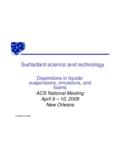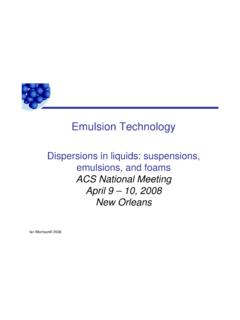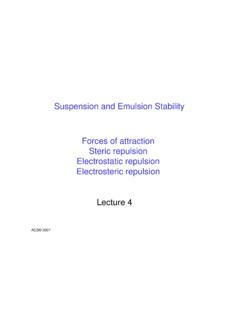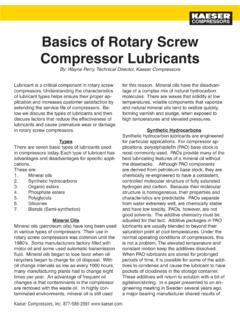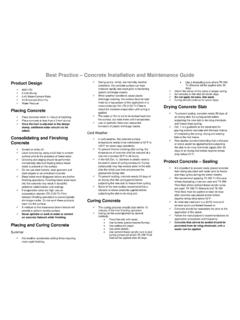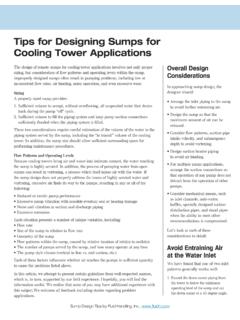Transcription of Lecture 6 Foam technology - Colloidal Dispersions
1 foam technology Lecture 6. Jean Sim on Chardin (1699-1779). ACS 2007. Bubble Geometry The Laplace equation for bubbles: 4 . p =. r Different curvatures show different pressures. ACS 2007 Lecture 6 - foam technology 1. foam Structures foam structure of a wet spherical foam made with Sodium Caproyl Lactylate at 400X magnification foam structure of dry hexagonal foam from cocoamidopropyl betaine at 400X magnification ACS 2007 Lecture 6 - foam technology 2. Plateau border Exerowa and Kruglyakov, p. 15. ACS 2007 Lecture 6 - foam technology 3. The Kelvin tetrakaidecahedron Gibbs angle Lamella Plateau border ACS 2007 Lecture 6 - foam technology 4. Formation of bubbles Exerowa and Kruglyakov, p. 2. ACS 2007 Lecture 6 - foam technology 5. Formation of foams Two bubbles floating at the liquid-air interface: A B A'. The pressure in the liquid at B is less than that at A or A'.
2 ACS 2007 Lecture 6 - foam technology 6. Draining foam Films ~rkt/tutorials/ ACS 2007 Lecture 6 - foam technology 7. Measuring film stability Exerowa and Kruglyakov, p. 44. ACS 2007 Lecture 6 - foam technology 8. Uneven film drainage Wasan et al. discovered the stepwise thinning of thin films. The stable thicknesses are layers of close-packed micelles. Exerowa and Kruglyakov, p. 221. ACS 2007 Lecture 6 - foam technology 9. Formation of black films Exerowa and Kruglyakov, p. 120. ACS 2007 Lecture 6 - foam technology 10. Surface viscosimeter Worm gear Head of stand Chuck Wire Mirror Knife edge Chuck Disk Liquid surface Channel to equalize pressure Dish Torsional pendulum for measurements of surface viscosity. ACS 2007 Lecture 6 - foam technology 11. Deep-channel surface viscosimeter Fixed outer cylinder Fixed inner cylinder Channel Liquid Rotating dish ACS 2007 Lecture 6 - foam technology 12.
3 Dynamic foam Stability To gas flow meter foam Liquid level Nitrogen Fritted glass Ross & Suzin, Langmuir, 1985, 1, 145-9. ACS 2007 Lecture 6 - foam technology 13. Equation of State of foam 4 . Consider a single bubble: p P =. r For a sphere: V r =. A 6. For an ideal gas: pV = nRT. Combining gives: 2. pV + A = nRT. 3. Assume this is true for a foam . The differential form is: 3V. dA= dP. 2 . Text p. 297. ACS 2007 Lecture 6 - foam technology 14. Static foam Stability Liquid Gas Computer Pump Humidifier Pressure Transducer Flow Controllers E F. C. foam B Sample Reference Generator Chamber Chamber A. D. Heat Exchanger Thermostat A schematic of the apparatus used. The jacketed sample vessel is graduated for rough estimates of foam volume. Nishioka & Ross, J. Colloid Interface Sci., 1981, 81(1), 1-7. ACS 2007 Lecture 6 - foam technology 15. foam Drainage Syneresis.
4 Drainage is through lamellae (initially) and then through the Plateau borders. Empirical equations can be used to fit the data: (. V = V0 1 e kt ) or V=. V02kt 1 + V0 kt where V is the volume of liquid. It is sometimes possible to add liquid to the top of the foam and measure drainage through the foam . ACS 2007 Lecture 6 - foam technology 16. Rheology of Foams Strain Elastic solid Liquid Plastic solid Stress Yield Point At low stresses, bubbles deform and the foam is plastic. At higher stresses, bubbles rearrange. At highest stresses, the bubbles flow. ACS 2007 Lecture 6 - foam technology 17. Theories of foam Stability Why doesn't a foam film fall? Marangoni effects. Requires slow diffusion of surfactant to stretched surface. Marangoni effects are important in spontaneous healing of thin spots and in foam destruction by antifoaming agents.*. Fluid viscosity.
5 Especially when high MW materials are present, gelatin or proteins. Surface viscosity. Mutual repulsion of electrical double layers. Formation of layers of micelles "spacing" the surface apart. Formation of liquid crystalline phases in the thin films (originally associated with black films.). *Explains why foam stability near saturation is often diminished. Above the CMC, the micelles serve as reservoirs for the surfactant. ACS 2007 Lecture 6 - foam technology 18. Stability due to Marangoni flow ow + Ma ra i F l ngo gon ow Gr av i ni F. aran l Fl ta ti low M na on i ta tio al r av Flo G w ACS 2007 Lecture 6 - foam technology 19. Electrostatic stabilization of a foam film - - +. +. Air - - + Air +. - - +. +. - + - + +. - Each interface is electrically charged. As the film thins, the repulsion increases. ACS 2007 Lecture 6 - foam technology 20. Liquid crystals stabilize foams Micelle Air Air Liquid crystal ACS 2007 Lecture 6 - foam technology 21.
6 Foaminess and Phase Diagram Isophroic Contours Not just solutions of "surfactants" foam . Partially miscible liquids in multiple components foam near the critical point (two components) or plait point (three or more components.) Surface activity precedes phase separation. If the separated phase has a lower surface tension, it will be a defoamer. Text p. 311. ACS 2007 Lecture 6 - foam technology 22. Ross' Rule Capillary effects are dramatic near phase boundaries. Capillarity has been shown to inhere in multicomponent systems at conditions characterized by certain locations in phase diagrams that display partial miscibilities of two liquid phases. - Ross' words Examples: Adsorption precedes precipitation. Foaming can suddenly increase or disappear. Dispersion stability suddenly changes. Surface and interfacial tensions change abruptly near phase boundaries.
7 The number and size of precipitates depend strongly on the position in the phase diagram. Sudden changes in product behavior may indicate some component is near its solubility limit. Text ACS 2007 Lecture 6 - foam technology 23. Foaming of whiskey Ethanol (% weight). 30. Bubble stability (s). 25. 20. 15. 10. 5. 0. 80 90 100 110. o US Proof (60 F). Davidson, J. Colloid Interface Sci, 1981, 81(2), 541. ACS 2007 Lecture 6 - foam technology 24. Three Phase Foams Powders with finite (receding) contact angles sit at the air/liquid surface. "Collectors" are sometimes added to aid this dewetting of particles. The particles move with the bubble - flotation. Particles may stabilize thin films if they have low contact angles, holding the two interfaces apart. The finer the particles, the better the stability; lead, silica, ferric oxide are examples. ACS 2007 Lecture 6 - foam technology 25.
8 foam Inhibition and Breaking Differentiate: foam inhibition and foam breaking. foam inhibitors - added before foam forms, displace foaming agents, or solubilizing the foaming agents (in micelles). foam breaking - mechanical, shock waves, compression waves, ultrasonics, rotating discs, heating, an electrical spark. Antifoams - added to existing foams, in the form of small droplets, which spread on the lamellae, thinning and breaking it. Antifoams for lubricating oils - poly(hexadecyl methacrylate) plus glycerol monoricinoleate, potassium oleate, nitro-substituted aliphatic alcohols, metal salts of copolymers of styrene and maleic anhydride. (Bikerman). ACS 2007 Lecture 6 - foam technology 26. Mechanisms of Antifoaming Contact with a hydrophobic interface, such as Teflon/water, siliconized solid/water. Addition of an insoluble, low-surface-tension liquid to a standing foam .
9 Typically, naturally occuring, oils, lard, fatty acids and alcohols, silicone oils, Presence of vapor of a volatile liquid. Contact with a hot source, such as an electrically heated wire. Destruction of a foaming agent by precipitation or heat. Soap added to a protein (as in distillation of whiskey, etc.) or acid added to a soap solution or cationic agent added to an anionic agent. Combating the Marangoni effect by a rapid attainment of static surface tension on addition of low molecular weight amphipaths. ACS 2007 Lecture 6 - foam technology 27. Silicone antifoams Silicone oil is emulsified into water with about HLB = 8. dispersant. Silicones are "activated" by the addition of 3-4%. silica. Hydrophilic silica is heated in the oil. The PDMS spreads, but is retarded by the silica leading to a reasonable sized weakness in the lamella. Hypothesis: it is the silica particle that is the defoamer!
10 The silicone oil is only the carrier. Silicone antifoams by Kulkarni et al. in Prud'homme and Khan, Chapter 14. ACS 2007 Lecture 6 - foam technology 28. Effect of PDMS Viscosity on Foaming 2 .0. foam fomration rate (mL s ). -1. 1 .5. 1 .0. 0 .5. 0 .0. -7 -6 -5 -4 -3 -2 -1. lo g (K in e tm a tic v is c o s ity ), m 2 s -1 @ 2 5o C. At low molecular weight (<250) the polymer is too soluble in the ester to be surface active. At intermediate molecular weights (ca. 6000) the polymer is less soluble and is surface active and is a profoamer. At higher molecular weights (>60,000) the polymer is insoluble but spreads on the bubble surface and acts as a foam inhibitor. Centers, Tribology Trans., ACS 2007 Lecture 6 - foam technology 29. 1993, 36(3), 381. Antifoams (a). (b). (c). (a) Antifoam drop (b) Entering the surface (c ) Leading to rupture of the film.
